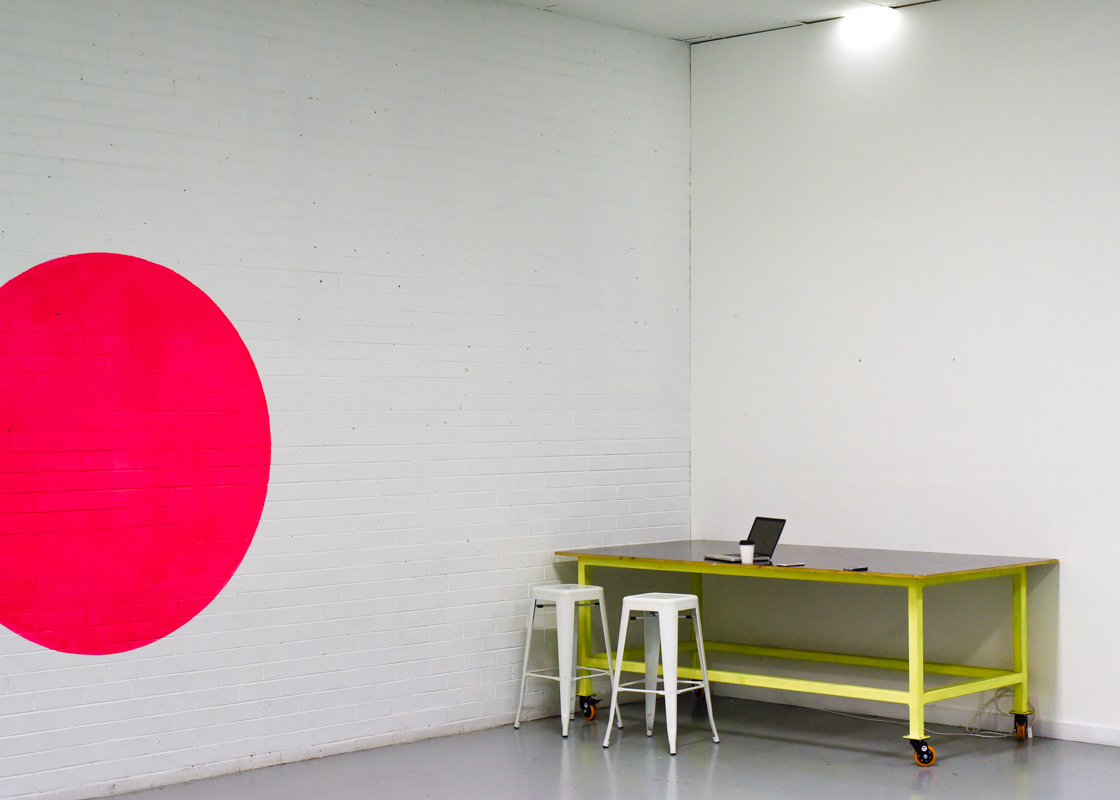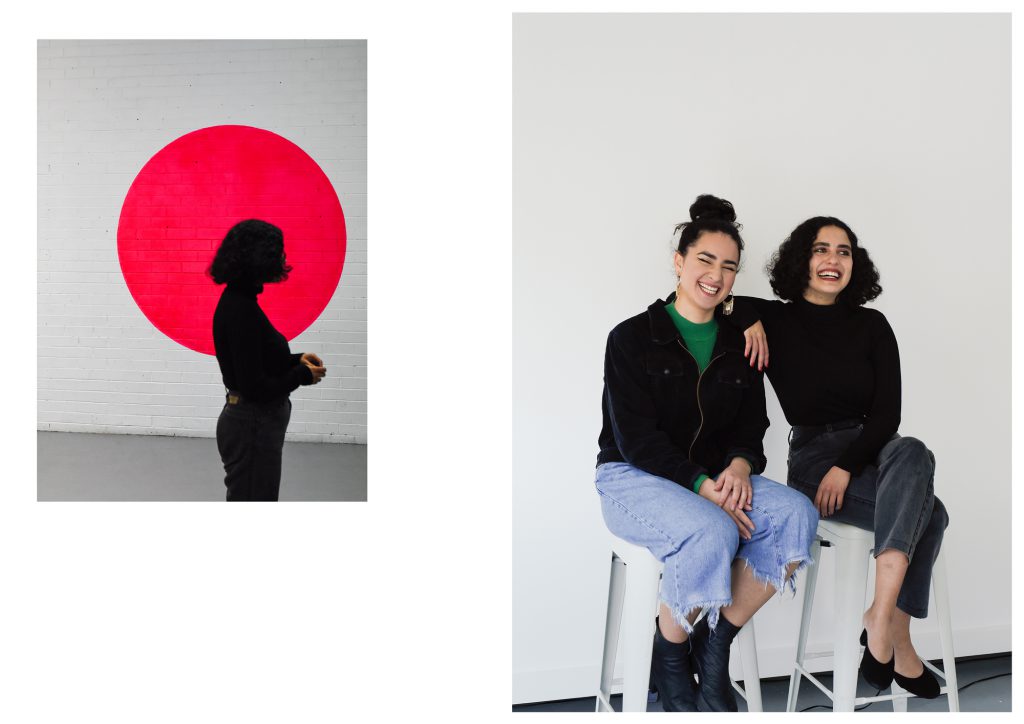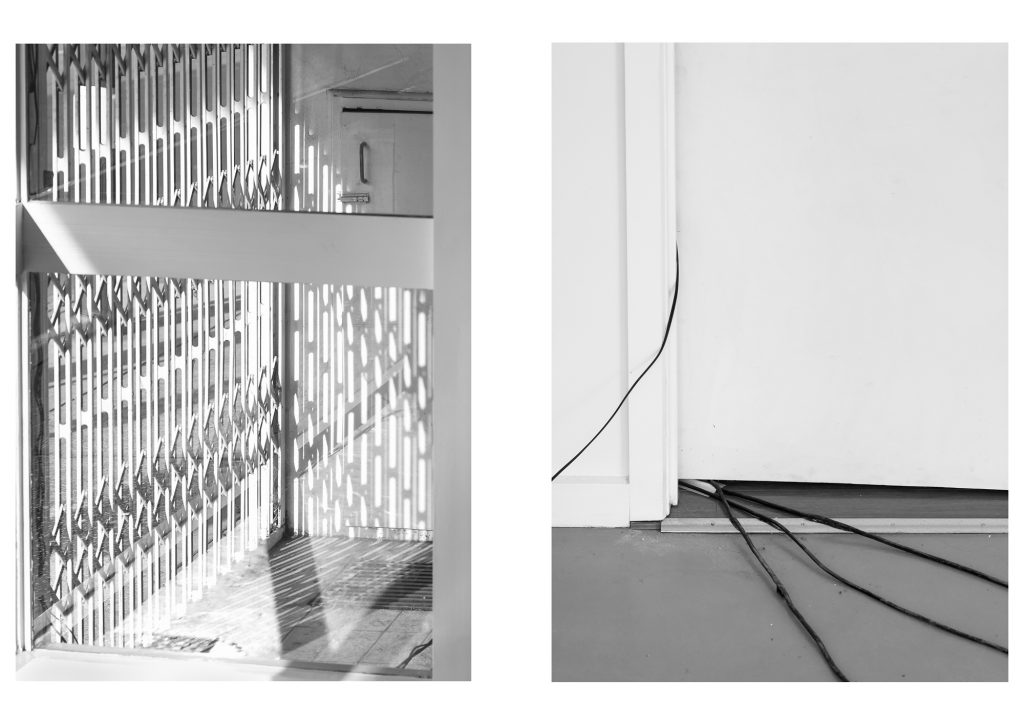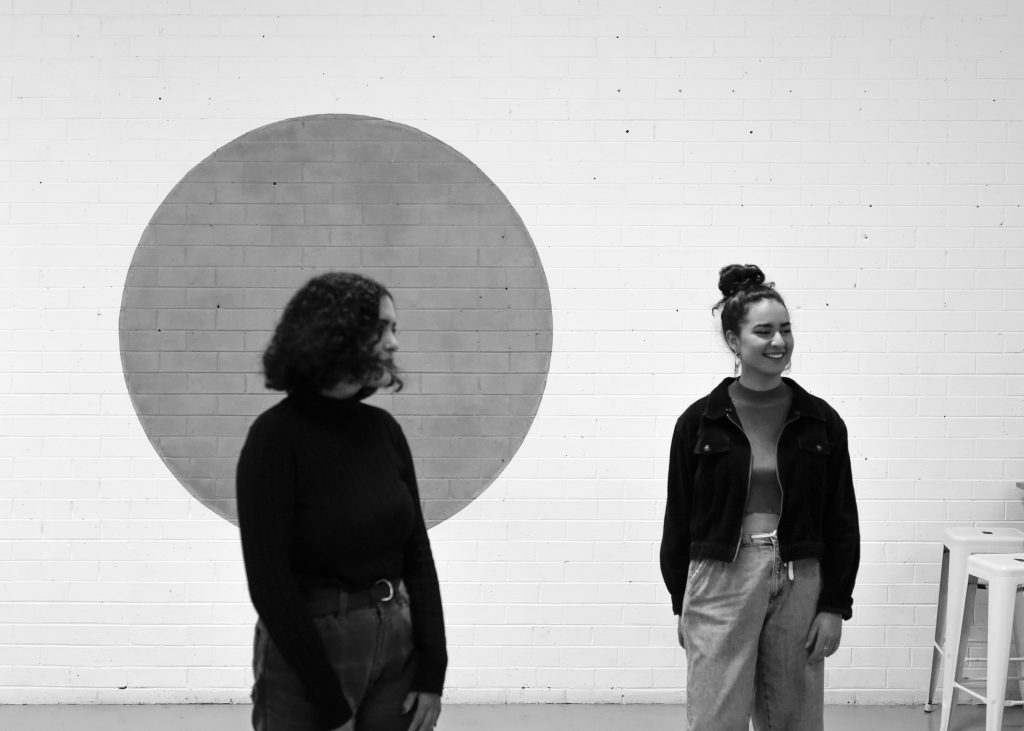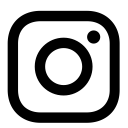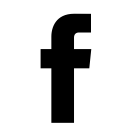Visuals / Interview
"...if we can get people talking I think we’ve been successful..."
Helena & James from Trouble Juice talk with Catherine & Luisa of Neon Parlour about the lead up, working process and fruition of their curatorial debut in VALID - an upcoming show at Neon Parlour concerned with the dialogue between artist and audience, and its pivotal impact on the confirmation of selfhood.
Ranging across various mediums and subject matter, all works are intrinsically linked by their engagement with the roles of vulnerability, validation and personal experience in a contemporary world.
Helena: Let’s start with introducing yourselves, your background in arts and how you both started curating.
Catherine: My name’s Catherine and my background in arts is that I did a Bachelor of Arts with a Major in Art History and then last year I did a Graduate Certificate in Visual Arts - so no formal curating background.
Luisa: I’m Luisa, I’m 19 and I’m a Fine Arts student at RMIT - it’s my first year this year. I became interested in galleries and curating while I was in VCE, so when I was on my gap year I became involved in some internships and volunteering - that’s pretty much the extent of my curatorial knowledge.
H: How did you guys meet?
C: Through volunteering. I started 18 months ago through Neon Parlour, which does life drawing on Tuesdays. I started doing that at the start of last year and the artist that owned the space was involved so I got to meet them, then got into volunteering. Then Luisa started after there was an exhibition she was interested in.
H: So have you been doing this for a while as well?
L: Yeah, so I started around May last year. I came to see the Accidental Discharge show - the group show they had here. Seeing the energy and the space really got me interested in volunteering, so I contacted the director and just became involved in weekly gallery sitting sessions. At the time I think Catherine and I were the only volunteers at Neon Parlour so we’d run into each other quite frequently. And then we undertook some training for the volunteer program and through that we kind of got to know each other a bit better and then realised we had a similar taste in art, so when we had the opportunity to work together on a project we thought it would be nice to put it into action.
C: To use the platform we’ve been given.
Catherine: My name’s Catherine and my background in arts is that I did a Bachelor of Arts with a Major in Art History and then last year I did a Graduate Certificate in Visual Arts - so no formal curating background.
Luisa: I’m Luisa, I’m 19 and I’m a Fine Arts student at RMIT - it’s my first year this year. I became interested in galleries and curating while I was in VCE, so when I was on my gap year I became involved in some internships and volunteering - that’s pretty much the extent of my curatorial knowledge.
H: How did you guys meet?
C: Through volunteering. I started 18 months ago through Neon Parlour, which does life drawing on Tuesdays. I started doing that at the start of last year and the artist that owned the space was involved so I got to meet them, then got into volunteering. Then Luisa started after there was an exhibition she was interested in.
H: So have you been doing this for a while as well?
L: Yeah, so I started around May last year. I came to see the Accidental Discharge show - the group show they had here. Seeing the energy and the space really got me interested in volunteering, so I contacted the director and just became involved in weekly gallery sitting sessions. At the time I think Catherine and I were the only volunteers at Neon Parlour so we’d run into each other quite frequently. And then we undertook some training for the volunteer program and through that we kind of got to know each other a bit better and then realised we had a similar taste in art, so when we had the opportunity to work together on a project we thought it would be nice to put it into action.
C: To use the platform we’ve been given.
H: What was that training process like, was it really formal?
L: It was pretty informal.
C: Yeah, just because the space is new itself so…
H: How new is it?
C: I think about six months before I started it opened up, so…
J: Around two years?
C: Yep! And so they haven't really had a volunteer program but, they’re really hands on with teaching us all the different things that go into running the gallery. The director would spend days taking us around to other artist run spaces, or letting us help him install exhibitions and things like that. Just kind of figuring out what we’re interested in as well.
J: So, it’s like a really kinda small, tight knit crew?
C: Yeah, yeah. It’s really nice.
J: Usually you’d imagine more established spaces to be just like, you’ve got the director and then numerous people in the ‘ranks’, and then you’ve got the volunteers, which means that just reaching them would be so difficult because you’ve got all these people to sift through - it'd create a really tricky dynamic. But this is awesome, that it’s so face to face.
C: Yeah and it’s like a really close relationship - they’re really aware of making sure that we’re getting out of it what we want as well. Because they’re so appreciative of us spending our time here.
H: How much time do you individually or both come in?
C: Lately not as much, but we were doing one day a week for a while.
L: It was pretty informal.
C: Yeah, just because the space is new itself so…
H: How new is it?
C: I think about six months before I started it opened up, so…
J: Around two years?
C: Yep! And so they haven't really had a volunteer program but, they’re really hands on with teaching us all the different things that go into running the gallery. The director would spend days taking us around to other artist run spaces, or letting us help him install exhibitions and things like that. Just kind of figuring out what we’re interested in as well.
J: So, it’s like a really kinda small, tight knit crew?
C: Yeah, yeah. It’s really nice.
J: Usually you’d imagine more established spaces to be just like, you’ve got the director and then numerous people in the ‘ranks’, and then you’ve got the volunteers, which means that just reaching them would be so difficult because you’ve got all these people to sift through - it'd create a really tricky dynamic. But this is awesome, that it’s so face to face.
C: Yeah and it’s like a really close relationship - they’re really aware of making sure that we’re getting out of it what we want as well. Because they’re so appreciative of us spending our time here.
H: How much time do you individually or both come in?
C: Lately not as much, but we were doing one day a week for a while.
J: Could you introduce or discuss the premise of the upcoming show?
L: So for the show, we really wanted to focus on something that was relevant to our community and the gallery’s local community as well. I think in our circles and society we’re definitely faced with a lot of pressures on social media these days and I think having the internet as a platform too, people are becoming more and more aware of social issues.
C: Yeah, well we kind of decided that we would build a show based on what we were passionate about, and the concept of validation was coming through the artists we were both interested in…
L: I think we found a couple of artists that we both knew that we really liked and through that a few ideas sparked, like; what did we really take away from their artwork? We found that we became really interested in the whole concept of validation through art. And so we were interested in how an audience can be validated in their experience through experiencing an artwork whilst at the same time the artist’s experience is being validated through sharing with their audience.
J: Yeah, actually there’s so many points in there that spark other little questions that relate to that - I guess firstly, it’d be cool to touch on the process in terms of curating a show - it sounds like it was much more a case of looking at artists first in that their work set up the premise of the show rather than finding the artists that would fit a predetermined idea. Does that sound like the process you were following?
C: Yeah, I think for this show in particular, there were a few key artists that we saw that kind of relationship between, but then once we realised exactly what it was that we’re interested in we researched and formed the concept before approaching any artists - and we were so lucky that the ones that we wanted and were initially talking about agreed to be in the show. So it’s all just come together really fluidly.
H: Yeah that is really nice, that instance of finding an idea through who has inspired you or touched you on a certain level but then reassessing and moulding that into a concept that is quite resolved throughout.
C: Yeah and there was a lot of editing going on in the original list of artists. It changed a lot before we got to the people that we realised were actually what we were talking about.
J: So with that dialogue that you’ve created or at least engaged with, between an audience’s validation as well as that of the artist, I was wondering where in that relationship you see yourself as curators? Where do you think your place is in that?
C: Well, we were talking about that because we hadn’t really thought about it that much, but it kind of is funny because the concept comes full circle; now there's these artists that are validating our ideas and our experiences through encouraging us and being in the show. And then through them their audience and it’s all just… yeah!
J: Yeah, like everyone it reaches or everyone involved kind of feeds off one another.
C: Exactly! We like seeing the positive flow-on effects that this is having.
L: I think by inviting artists to be involved in this exhibition in a real space, bringing people to the opening and having that community present - you’re able to kind of connect with the people around you and see that your experiences and feelings might be shared with the people that are in your immediate space.
C: We really just want to open up a dialogue and hope that - like, we know it’s not going to be perfect because it’s the first time we’ve tried our hand at anything like this - but if we can get people talking I think we’ve been successful.
L: So for the show, we really wanted to focus on something that was relevant to our community and the gallery’s local community as well. I think in our circles and society we’re definitely faced with a lot of pressures on social media these days and I think having the internet as a platform too, people are becoming more and more aware of social issues.
C: Yeah, well we kind of decided that we would build a show based on what we were passionate about, and the concept of validation was coming through the artists we were both interested in…
L: I think we found a couple of artists that we both knew that we really liked and through that a few ideas sparked, like; what did we really take away from their artwork? We found that we became really interested in the whole concept of validation through art. And so we were interested in how an audience can be validated in their experience through experiencing an artwork whilst at the same time the artist’s experience is being validated through sharing with their audience.
J: Yeah, actually there’s so many points in there that spark other little questions that relate to that - I guess firstly, it’d be cool to touch on the process in terms of curating a show - it sounds like it was much more a case of looking at artists first in that their work set up the premise of the show rather than finding the artists that would fit a predetermined idea. Does that sound like the process you were following?
C: Yeah, I think for this show in particular, there were a few key artists that we saw that kind of relationship between, but then once we realised exactly what it was that we’re interested in we researched and formed the concept before approaching any artists - and we were so lucky that the ones that we wanted and were initially talking about agreed to be in the show. So it’s all just come together really fluidly.
H: Yeah that is really nice, that instance of finding an idea through who has inspired you or touched you on a certain level but then reassessing and moulding that into a concept that is quite resolved throughout.
C: Yeah and there was a lot of editing going on in the original list of artists. It changed a lot before we got to the people that we realised were actually what we were talking about.
J: So with that dialogue that you’ve created or at least engaged with, between an audience’s validation as well as that of the artist, I was wondering where in that relationship you see yourself as curators? Where do you think your place is in that?
C: Well, we were talking about that because we hadn’t really thought about it that much, but it kind of is funny because the concept comes full circle; now there's these artists that are validating our ideas and our experiences through encouraging us and being in the show. And then through them their audience and it’s all just… yeah!
J: Yeah, like everyone it reaches or everyone involved kind of feeds off one another.
C: Exactly! We like seeing the positive flow-on effects that this is having.
L: I think by inviting artists to be involved in this exhibition in a real space, bringing people to the opening and having that community present - you’re able to kind of connect with the people around you and see that your experiences and feelings might be shared with the people that are in your immediate space.
C: We really just want to open up a dialogue and hope that - like, we know it’s not going to be perfect because it’s the first time we’ve tried our hand at anything like this - but if we can get people talking I think we’ve been successful.
J: Since there is this process of validation between artists and viewers that really exists, I was curious if you guys thought that existed in other worlds. For example, a chef would put their heart and soul into a dish, that would be (hopefully) validated by a customer. I was wondering if you saw this kind of idea extending beyond an artistic world, and it being more a question of passion or ambition, or vulnerability, in a sense? Which is something that might be the crux of that dialogue. I was wondering if either of you saw that same thing?
C: Yeah, I think vulnerability is a key thing that we’ve been talking about because that is really what it takes to put yourself out there and to give other people that opportunity to validate you.
J: Yeah, it sets up that framework for validation.
C: And it just happens everyday. We were talking about it in terms of expressing your feelings, like you just need to put yourself out there to then realise that your experiences are shared, that they are human and other people will connect with you if you can allow yourself to do that.
J: And in terms of constructing a show within a physical space, have you felt any restrictions of working with visual items that are relatively 2D. I’m wondering, in terms of constructing a show in a three dimensional space, if there are any limitations that you faced, conceptually speaking?
C: I think it’s actually been an exciting process because we approached our artists and they’ve actually all wanted to respond directly to our theme, so a lot of the work we still aren’t sure what its finished form is going to look like. We won’t really know until we come to install it in the coming weeks, but that’s just a really exciting thing for us all to come through together and see how it all works out. But, yeah there are definitely challenges of trying to make sure everything is cohesive and does make sense to the viewer.
H: So there are quite a few different mediums? There’s film work… some poetry as well, is that right?
C: Yeah, so we’re going to have the spoken word performance by Madison Griffiths, which will be really nice, and then we’ve got some illustrations and paintings and I think textile works as well, so it will be interesting once we get them all in the space and just see how it’s going to pan out.
H: So that process will begin in the next couple of weeks?
C: Yeah! So we will just receive the works in about – two weeks – just under two weeks.
H: Leaving you with…?
C: A couple of days…
*we all share nervous laughter*
H: But you guys are very familiar with the space so that’ll be really fun!
C: We’re familiar with the space so we’ve been in contact with the artists - like we know at least the medium, and the dimensions of the work.
J: Do you feel any pressure as curators to essentially create an environment or an atmosphere that becomes greater than the sum of its parts? You have all of these different artists that are contributing, so do you feel like you’re compelled to create something that’s greater than what exists individually?
C: I think because this is something that’s so new to us is that we haven’t even [considered it]. Like, we're quite naive in that we haven’t felt that way and aren’t feeling that kind of pressure. And we just really wanted to make a platform for these artists to give them the opportunity to do what they want to do, so as long we as do that…
L: Yeah I think so. And I think everyone that experiences the show is going to take away something else from that. But I think by having that concept that’s tying everything together, hopefully the viewer’s attention is drawn to certain ideas and they do come away with an overall kind of experience - but I guess everyone’s experience is going to be unique and we’re not going to try and focus on, you know, trying to force anything.
J: You spoke about internet as a platform before as well - is it difficult to sift through the endless possibilities of people that you could draw in?
C: To be in the show?
J: Yeah, to be in the show - say you’re looking for people that build your premise. Is it a big process to narrow down or know when to stop searching and be like "okay I’ve got these, these and these…"
L: I think we never had a giant list that we were trying to cut down on. We kind of had a few people in mind but then through those core and original people we had, and through their platforms as well, we found people that they knew. So a lot of the artists do know each other through platforms like Instagram. And as we wanted to make it as cohesive as possible we didn’t want there to be too many artists; we wanted to give each artist enough physical space in the gallery to explore their ideas to their full potential instead of cramming a lot of smaller works into the space.
C: I think because this is something that’s so new to us is that we haven’t even [considered it]. Like, we're quite naive in that we haven’t felt that way and aren’t feeling that kind of pressure. And we just really wanted to make a platform for these artists to give them the opportunity to do what they want to do, so as long we as do that…
L: Yeah I think so. And I think everyone that experiences the show is going to take away something else from that. But I think by having that concept that’s tying everything together, hopefully the viewer’s attention is drawn to certain ideas and they do come away with an overall kind of experience - but I guess everyone’s experience is going to be unique and we’re not going to try and focus on, you know, trying to force anything.
J: You spoke about internet as a platform before as well - is it difficult to sift through the endless possibilities of people that you could draw in?
C: To be in the show?
J: Yeah, to be in the show - say you’re looking for people that build your premise. Is it a big process to narrow down or know when to stop searching and be like "okay I’ve got these, these and these…"
L: I think we never had a giant list that we were trying to cut down on. We kind of had a few people in mind but then through those core and original people we had, and through their platforms as well, we found people that they knew. So a lot of the artists do know each other through platforms like Instagram. And as we wanted to make it as cohesive as possible we didn’t want there to be too many artists; we wanted to give each artist enough physical space in the gallery to explore their ideas to their full potential instead of cramming a lot of smaller works into the space.
H: You were saying that you’re still in the process of receiving artworks - as this is your first time curating, has there been any kind of major bumps so far? Or things that you’re excited to change or develop in the future? Or has anything really stood out in this process?
C: We’ve had a lot of support from the gallery so it’s been pretty easy. We’ve mapped it all out so any hiccups we’ve come across we’ve been able to get through. It’s good doing it with someone as well, like I think if I was doing it by myself I’d find it a lot more challenging but we’ve been able to balance each other out very well.
L: I think the whole experience of really doing it, as opposed to just learning about curation, is really a lot different and you experience a lot of things that you would never learn about in a classroom, so that experience is so valuable as well. Kind of working through [it all]. I think the biggest hurdle for us was really refining our concept and trying to narrow that down to exactly what we wanted it to be, in a way that our ideas were going to translate to the audience.
C: Narrowing down all of our thoughts into like 200 words, or whatever we had to do. That was definitely the hardest part.
H: Yeah definitely. Going back to what Luisa said before about hands-on experience – I think it's quite true, especially when putting something like this together. Personally, a lot of people that I’ve ended up working with have said "…you don’t really need to study events…".
You need to be on the ground, and really meeting people, and just learning those skills first hand, rather than seeing them in text. Putting them all into practice is really important and it’s so great that you guys have been given the opportunity to curate your own shows without having to necessarily go through that process. It’s really great how the idea has come through the artists and how the concept has kind of come full circle - I think it’ll be really great to see, I’m so excited.
C: It’s been a long time coming.
H: How long has it been since you…?
C: Well we pretty much wanted to have everything sorted eight weeks before the show so.
H: And when did you start sort of… planning?
C: Ooh like the idea? About six months ago?
L: I think the first idea of curating a show was like twelve months and then finally started talking about it and refining our concepts about six months ago.
J: Has it all just come and passed in what seems like five seconds?
L: Yes! We can’t believe there’s only two weeks to go.
J: It’s like there’s one day where you’re like ‘oh, this would be cool’… ‘yeah alright’ and then bam.
C: Yeah, two weeks…
C: We’ve had a lot of support from the gallery so it’s been pretty easy. We’ve mapped it all out so any hiccups we’ve come across we’ve been able to get through. It’s good doing it with someone as well, like I think if I was doing it by myself I’d find it a lot more challenging but we’ve been able to balance each other out very well.
L: I think the whole experience of really doing it, as opposed to just learning about curation, is really a lot different and you experience a lot of things that you would never learn about in a classroom, so that experience is so valuable as well. Kind of working through [it all]. I think the biggest hurdle for us was really refining our concept and trying to narrow that down to exactly what we wanted it to be, in a way that our ideas were going to translate to the audience.
C: Narrowing down all of our thoughts into like 200 words, or whatever we had to do. That was definitely the hardest part.
H: Yeah definitely. Going back to what Luisa said before about hands-on experience – I think it's quite true, especially when putting something like this together. Personally, a lot of people that I’ve ended up working with have said "…you don’t really need to study events…".
You need to be on the ground, and really meeting people, and just learning those skills first hand, rather than seeing them in text. Putting them all into practice is really important and it’s so great that you guys have been given the opportunity to curate your own shows without having to necessarily go through that process. It’s really great how the idea has come through the artists and how the concept has kind of come full circle - I think it’ll be really great to see, I’m so excited.
C: It’s been a long time coming.
H: How long has it been since you…?
C: Well we pretty much wanted to have everything sorted eight weeks before the show so.
H: And when did you start sort of… planning?
C: Ooh like the idea? About six months ago?
L: I think the first idea of curating a show was like twelve months and then finally started talking about it and refining our concepts about six months ago.
J: Has it all just come and passed in what seems like five seconds?
L: Yes! We can’t believe there’s only two weeks to go.
J: It’s like there’s one day where you’re like ‘oh, this would be cool’… ‘yeah alright’ and then bam.
C: Yeah, two weeks…

